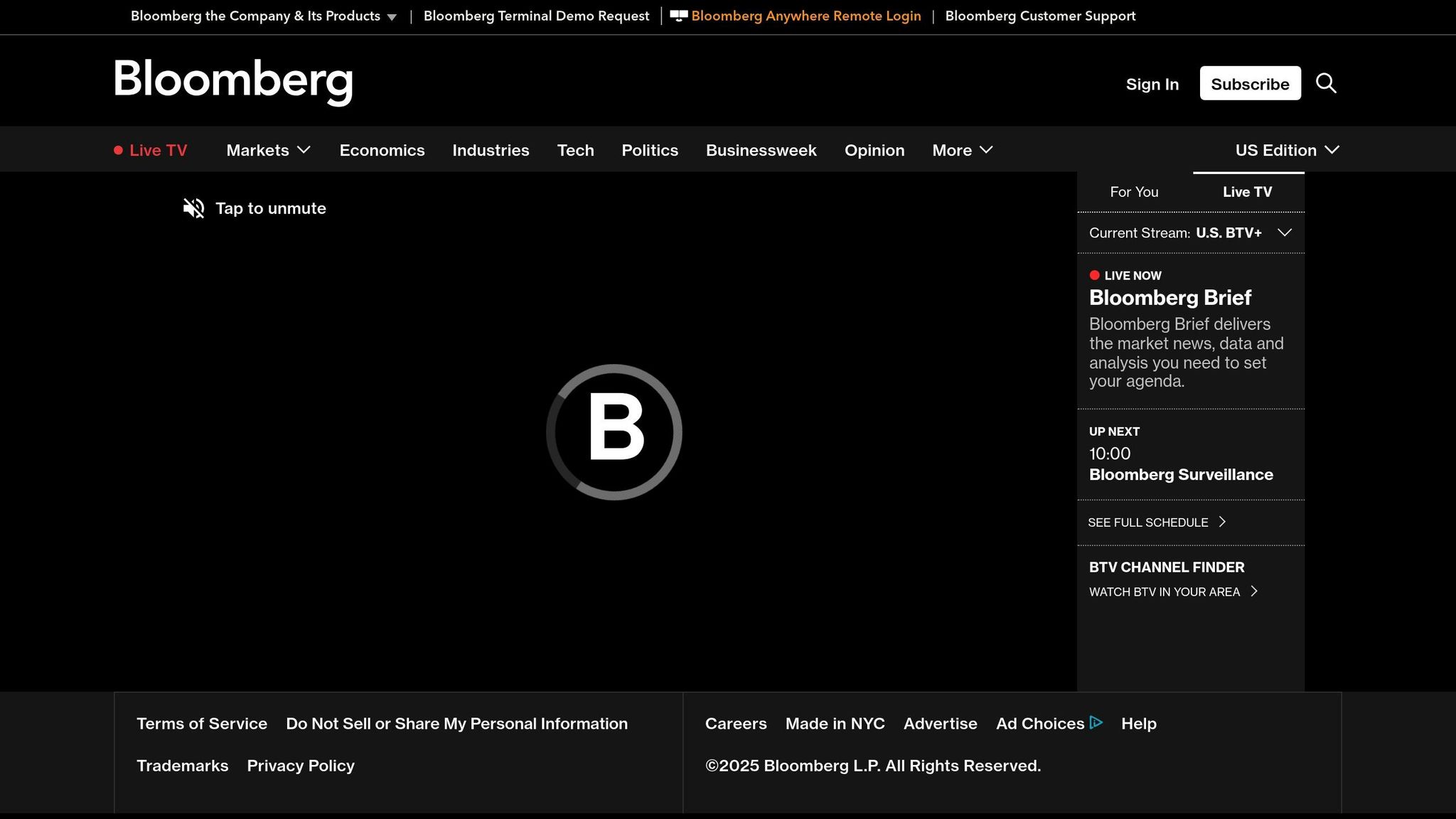Private equity (PE) layoffs are on the rise, especially in tech sectors like SaaS and AI. But are they driven by broader economic issues or PE-specific strategies? Here's the breakdown:
- PE-driven layoffs: Often tied to cost-cutting, debt management, or prepping for exits like sales or IPOs. These are usually planned after acquisitions or during financial reviews.
- Economic layoffs: Triggered by external factors like inflation, higher interest rates, or reduced consumer spending. These affect entire industries, not just individual companies.
Key differences:
- PE layoffs focus on short-term financial goals and may hurt long-term company growth.
- Economic layoffs respond to market conditions to maintain stability.
For companies, spotting early signs - like recent acquisitions or macroeconomic shifts - is essential to manage workforce changes effectively.
BloombergTV: Orlando Bravo on the PE industry and the importance of focusing on company fundamentals

1. PE Firm Layoff Causes
Private equity (PE) firms often operate with goals that set them apart from traditional corporate owners. These distinct priorities can lead to workforce reductions that don’t necessarily align with broader economic trends. Instead, PE firms often make headcount decisions based on their unique financial strategies and objectives.
Motivation
PE firms usually work within a tight investment timeline, which creates pressure to quickly boost cost efficiencies. Since labor expenses are often among the largest costs for businesses, cutting the workforce can appear to be a fast way to improve profit margins. When acquisitions are funded with significant debt, the urgency to generate consistent cash flow for debt servicing can drive immediate layoffs.
Preparing for an exit is another major factor. Whether aiming for a public offering or a sale, PE firms often focus on improving financial metrics to attract potential buyers or investors. By reducing staff and streamlining operations, companies can present stronger revenue-per-employee ratios, making them more appealing during the exit process.
Triggers
Layoffs in PE-owned companies are often tied to specific operational or financial review periods rather than external market conditions. For example, workforce reductions may follow early assessments after an acquisition, align with internal fiscal planning cycles, or occur in preparation for debt refinancing. These key moments often dictate when cost-cutting measures are implemented, especially in tech-driven industries.
Impact on SaaS/AI Workforce
In sectors like SaaS and AI, PE ownership can lead to cuts in roles that don’t contribute directly to short-term profitability. Functions such as product development or customer support may be scaled back as the focus shifts to immediate financial performance. Additionally, management structures are often reorganized to reduce overhead costs, which can result in the loss of middle management positions. This approach, however, can risk losing top talent and institutional knowledge.
Implications for Company Health
While the primary goal of PE-driven layoffs is to improve short-term financial outcomes, they can introduce significant operational challenges. Reducing investment in product development may hinder innovation, while cutting back on customer support could lead to increased customer attrition. A smaller engineering team might struggle to maintain infrastructure, potentially leading to rising technical debt. These short-term cost-saving measures can jeopardize a company’s long-term competitiveness and stability.
2. Economic Layoff Causes
Economic layoffs arise from external market forces that impact entire industries, rather than being tied to specific strategies or actions within individual companies, such as those often seen in private equity scenarios.
Motivation
Economic layoffs are typically driven by external pressures that threaten a company’s ability to grow or remain profitable. For instance, inflation can drive up operational costs, squeezing profit margins and prompting hiring freezes or cuts. Similarly, rising interest rates have a significant impact. A 100-basis-point drop in interest rates, for example, could boost the valuation of a high-growth SaaS company by 20–30%, assuming earnings remain stable [1]. On the flip side, rising rates lower valuations and tighten budgets. Broader economic slowdowns, marked by reduced consumer spending and business investment, also lead to diminished demand and revenue forecasts. This often forces companies to adjust staffing levels. Unlike layoffs influenced by private equity, which are often dictated by internal timelines, these decisions are a direct reaction to market conditions.
Triggers
Economic layoffs are frequently tied to clear macroeconomic indicators. Changes in interest rates or unexpected inflation trends can quickly lead businesses to reevaluate hiring plans and cash flow strategies.
Impact on SaaS/AI Workforce
For SaaS and AI companies, these economic challenges often result in a strategic pullback on non-essential hiring. By scaling back, these companies aim to align their workforce with reduced demand while maintaining core operations. This approach allows them to manage costs effectively during uncertain periods.
Implications for Company Health
Although economic layoffs can be difficult, they are generally a response to external conditions rather than internal failings. These measures are often necessary to safeguard a company’s long-term stability and position it for eventual recovery.
sbb-itb-9cd970b
Pros and Cons
Private equity (PE)-driven layoffs come with their own set of advantages and challenges. These layoffs impact employees and company operations in ways that can be both beneficial and problematic.
| Aspect | PE-Driven Layoffs |
|---|---|
| Motivation | Pros: Streamlines operations by eliminating non-essential roles, potentially boosting productivity. Cons: A heavy focus on maximizing profits often leads to steep wage cuts and higher employee turnover. |
| Triggers | Pros: Typically follow acquisitions, enabling structured planning for workforce adjustments. Cons: Often driven by acquisition timing rather than actual performance, which can create misalignment in priorities. |
| Impact on Workforce | Pros: Employees may be reassigned to roles that align with strategic goals. Cons: On average, employees at PE-acquired companies earn nearly 18% less within three years of acquisition, while those who move to new jobs face a smaller wage decline of just 0.5% [2]. |
| Company Health Effects | Pros: Targeted restructuring can lead to increased productivity and profitability. Cons: Many replacement roles come with lower pay, potentially affecting the company's long-term stability [3]. |
This dual nature of PE-driven layoffs highlights both opportunities and risks, offering valuable insights for companies navigating these changes.
Josh Lerner from Harvard Business School sheds light on this dynamic:
"PE firms stimulate productivity through a series of steps, which may include the movement of personnel and changing incentives" [2].
Data further supports this, showing that while employees who stay with PE-acquired companies often face considerable pay cuts, those who transition to new roles see much smaller reductions - around 0.5% [2].
Revelio Labs adds:
"To maximize profitability, private equity firms frequently implement large-scale cost-cutting measures, such as mass layoffs and workforce restructuring" [3].
For SaaS and AI companies, understanding these patterns is crucial for making informed decisions about workforce planning and long-term strategies.
Conclusion
Understanding the differences between private equity (PE) and macroeconomic layoffs is crucial for shaping workforce strategies in SaaS and AI industries. PE-driven layoffs often stem from strategic moves like cost-cutting and restructuring after acquisitions, with an average job loss rate of 4.4% within two years of a private equity takeover[5]. On the other hand, layoffs triggered by macroeconomic factors - such as inflation and rising interest rates - impact entire industries, creating a broader ripple effect.
The scale of these layoffs also varies significantly. PE-driven layoffs are usually confined to specific companies following acquisitions, while macroeconomic pressures have caused over 150,000 job cuts across 549 tech companies in early 2025 alone. Within this, the tech sector saw over 22,000 layoffs[4]. These numbers highlight the distinct patterns of workforce reductions tied to PE strategies versus broader economic challenges.
For SaaS and AI companies, spotting early warning signs is critical. Potential indicators of PE-driven layoffs include recent acquisitions, leadership changes, aggressive financial goals, and sudden operational shifts. On the other hand, macroeconomic risks may be signaled by declining industry-wide sales, rising inflation, tightening interest rates, and widespread layoffs across sectors.
To prepare for either scenario, businesses should focus on resilience. This includes maintaining healthy cash reserves, diversifying revenue sources, and fostering workforce adaptability through cross-training. For PE-backed companies - or those considering PE investment - open communication with stakeholders about priorities can help align strategies. By staying proactive, companies can better navigate targeted post-acquisition adjustments or broader economic pressures.
FAQs
How can you tell if layoffs are driven by private equity strategies or broader economic factors?
Layoffs linked to private equity (PE) strategies tend to focus on specific cost-cutting or restructuring efforts aimed at improving a company’s financial performance. These actions are often part of a larger plan to prepare the business for a sale or exit. Typically, they target particular departments or roles that align with the PE firm's operational priorities.
In contrast, layoffs triggered by macroeconomic factors - such as inflation, rising interest rates, or a recession - usually impact a broader range of industries. These layoffs are reactive, driven by external financial pressures, and are not part of a deliberate long-term strategy.
You can often spot PE-driven layoffs by their connection to restructuring plans tied to exit timelines and efforts to maximize short-term profitability. Economic layoffs, however, tend to be more widespread and less connected to internal company strategies.
How do layoffs driven by private equity affect the growth and innovation of SaaS and AI companies?
Layoffs initiated by private equity (PE) firms can have a profound effect on the progress and creativity of SaaS and AI companies. When these companies reduce their workforce, they risk losing crucial talent - individuals who play a vital role in research and development. This loss can hinder their ability to stay competitive in industries that evolve at lightning speed.
Beyond the immediate talent drain, aggressive cost-cutting measures often associated with PE ownership can create an atmosphere of uncertainty. Employees may become less willing to take risks or think beyond short-term goals, which can stymie innovation. For SaaS and AI companies, this hesitation to embrace bold ideas or plan strategically for the future could mean missing out on opportunities in a rapidly changing market.
Ultimately, striking the right balance between streamlining operations and continuing to invest in forward-thinking innovation is essential for these businesses to thrive over the long haul.
How can companies reduce the risks of layoffs caused by private equity strategies or economic challenges?
Companies can lower the chances of layoffs by broadening their revenue sources, exploring new markets, and encouraging fresh ideas. These strategies reduce dependence on a single approach or specific economic trends, creating a more resilient foundation.
On top of that, cost-saving moves like temporary wage freezes, shorter work hours, or reassigning employees to different roles can help keep the workforce intact. Focusing on streamlining operations and ensuring transparent, fair decision-making processes are also critical for navigating tough times while safeguarding employee morale and the company’s future stability.



